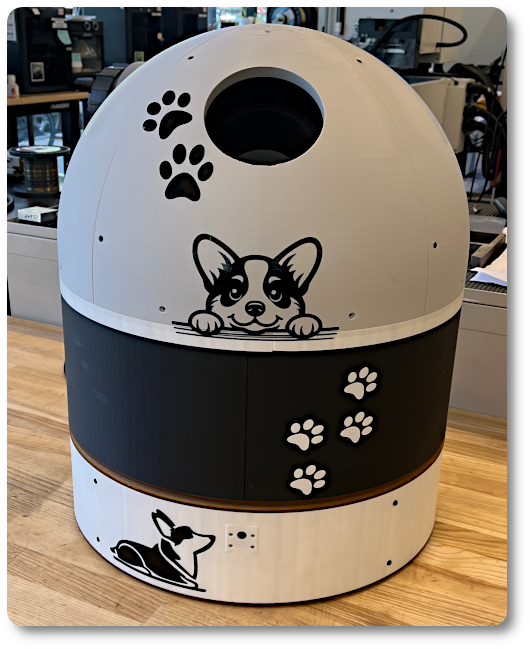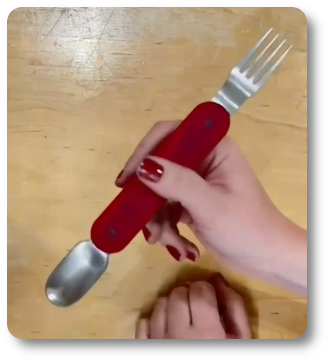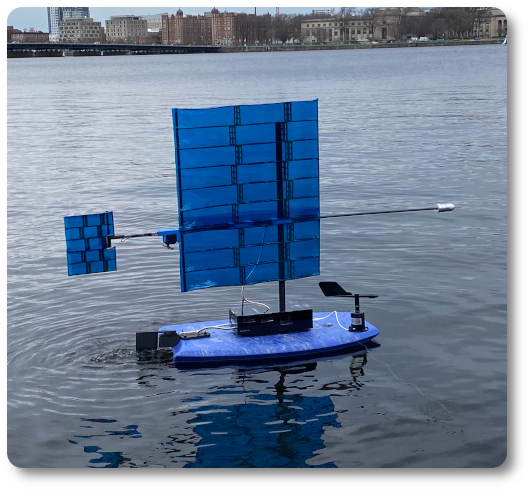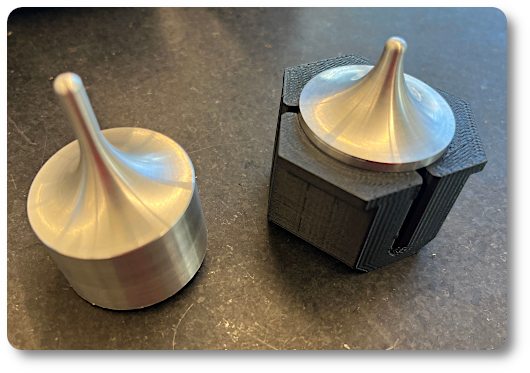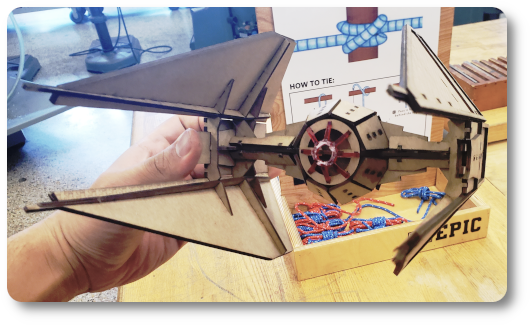Showcase
Interested in what we do at EPIC? We hope our Showcase will inspire you. Explore your peers innovative projects and find out how they were made possible!
Apply to be featured!
Automatic Dog Ball Thrower
by Ethan Steeg (2025) and Jess Daher (2025)
What was your inspiration? Class Assignment for ME460/461, Fall 2024 – Spring 2025, Professor Frank Di Bella
What problem does your product solve? The Automatic Dog Ball Thrower solves the problem of keeping highly energetic dogs entertained and exercised without constant human involvement. Many dog owners struggle to match their pet’s energy level, especially when their schedules are busy. This product uses a vision system and launching mechanism to safely play fetch with a dog autonomously, ensuring the dog gets enough activity while freeing the owner from having to repeatedly throw a ball.
How was your product made? What manufacturing processes did you use? What materials is it made of? The Automatic Dog Ball Thrower was built using a combination of 3D printing, machining, and rapid prototyping techniques. The launch mechanism features a spring-loaded platform compressed and released by high-force linear actuators. Two heavy-duty steel springs were guided by aluminum rods to ensure that the platform moved along a consistent launch path. This design provided both the force and directional accuracy needed for reliable ball launches. The launcher is mounted on a rotary turntable driven by a stepper motor, allowing it to adjust the ball’s launch direction. Custom components, such as the external housing and main body of the launching mechanism, were 3D printed using PLA plastics. HDPE parts were machined on a lathe for structural stability in high-stress areas, and internal platforms were made from laser-cut MDF boards. The final assembly integrates mechanical hardware with a live camera and a custom computer vision model that we trained to visually track the dog and determine the ball’s launch direction in real time. For aesthetics, custom vinyl stickers were cut using a vinyl cutter and applied to the outer surfaces to enhance the device’s visual appeal.
Words of wisdom for fellow innovators? One of the biggest lessons we learned was the importance of knowing when to pivot. We originally planned to use solenoids to unlock and release the spring-loaded platform, but they were not strong enough to do the job. Over the next two months, we implemented many different designs to make the solenoids work, but none of them were successful. Eventually, we decided to switch to high-force linear actuators, which immediately gave us the performance we needed. Persistence is important, but so is recognizing when a solution is not working. Being willing to completely change direction can save your project and lead to a much better outcome.
CMY no K(ey)
by Carolina Izsák (2024)
What was your inspiration? Thesis Exploration / Master of Fine Arts in Graphic Design
What problem does your product solve? Chance, Color, and the serendipitous outcomes of individual and collective free Play frame this project, requiring the viewers’ engagement for it to come alive and further create. Recording their experience with the elements provided and the visual aesthetic outcomes of their creations will be the generators of my future design work, one that started as a play on chance and one that will further be enriched by it. The colorful acrylic shapes were created by chance—a journey with no agenda in mind except to follow the flow of the line. In contrast, a structured pegboard serves as a canvas, bringing gravity and consistency into a sort of push and pull between freedom and constraint. The title, CMY no K(ey) is a play on words on the four-color printing process. Not only am I purposefully leaving K (black) out of the mix, but by doing so, the audience is denied of its “key,” freeing it from a prefixed image to which the colors CMY (cyan, magenta, and yellow) would have to align or register to. The goal is to allow space for free experimentation through the combination of shapes and color mixing aided by the material’s transparency. It’s an invitation to Experiment, Engage, and Play freely!
How was your product made? What manufacturing processes did you use? What materials is it made of? Colored translucent acrylic pieces cut with the laser cutter / wood board and pegs
Words of wisdom for fellow innovators? When the laser cutter is set to strong, it clouds the edges of the cut pieces.Visit Carolina’s website on CMY no K(ey) for more details!
Swiss Army Utensil: Dine Duo!
by Giulia Rigamonti (2024), Alfredo Murillo and Anh Nguyen
What was your inspiration? Class Assignment for ME537, Spring 24, Prof. Chomyszak
What problem does your product solve? The need for multiple utensils for camping.
How was your product made? What manufacturing processes did you use? What materials is it made of? Utensils were waterjet cut, fork was manually bent, spoon was stamped, Chassis was CNC Machined, and shell was resin casted. Utensils were tumbled and polished for finishing. Product is assembled using M2 screws.
Words of wisdom for fellow innovators? Always focus on design for manufacturing, so always think ‘how is this going to be made’ while you design it. And have buffers in your schedule, because sh*t happens and you cannot plan for everything.
AquaROVER
by Fahim Rabbi (2024), Lorenzo Moriche, Weinuo Lin, Samuel Haley, Natalie Menon
What was your inspiration? Class Assignment for ME461
What problem does your product solve? AquaROVER is to be used in K-12 education settings for data collection in water bodies. The Vehicle successfully uses wind energy for its propulsion; reducing its reliance on Battery energy.
How was your product made? What manufacturing processes did you use? What materials is it made of? The Sail was fabricated using MDF wood as its Skeletal Structure and then wrapped using Mylar for its Airfoil Shape. Each rib and spacer of the skeletal structure was laser cut at EPIC and then hand assembled. The Counterweight is made of aluminum and is machined using the CNC lathe. The keel, rudder and several Brackets were 3D printed.
Words of wisdom for fellow innovators? Laser cutting allowed us to go through several designs and prototypes rapidly. It was a much faster process than 3D printing ribs. Prototyping and starting the fabrication process early allowed us to learn from design errors and do iterations before having our fully functional project ready for its Bon Voyage.Visit Fahim’s website on the AquaROVER for more details!
Stencils of Custom Typography
by students in Brocket Horne’s class
What was your inspiration? Graphic Design Course in the School of Fine Arts
What problem does your product solve? Bespoke typeface transformed into stencils for graphic design packages
How was your product made? What manufacturing processes did you use? What materials is it made of? Acrylic sheets cut on the laser cutter and MDF engraved on the laser cutter
Words of wisdom for fellow innovators? This was an outstanding experience that will change how students design
Top Crafted on a CNC Lathe
by Tasker Smith, Staff
What was your inspiration? Personal Interest
What problem does your product solve? Solving the challenge of technical work-holding with a 3D Printed fixture on the lathe
How was your product made? What manufacturing processes did you use? What materials is it made of? 3D Printed fixture, aluminum top turned on TRAK 1630RX CNC lathe
Words of wisdom for fellow innovators? Describe any issues you had to overcome and what you learned from your experience making your product? This project required a lot of experimentation to overcome the challenge of holding an organic shape. Custom work-holding was required, and it was fun to experiment with 3D Printing as a strategy for holding this part after the first side had been turned on the lathe.Tie Interceptor
by Fredisvindo Bebe III, Class of 2025
What was your inspiration? Personal Interest
What problem does your product solve? Boredom, lack of decorations
How was your product made? What manufacturing processes did you use? What materials is it made of? Laser cut cardboard and acrylic, also superglue
Words of wisdom for fellow innovators? Describe any issues you had to overcome and what you learned from your experience making your product? Make sure your materials the right thickness, if its not, super glue two thinner boards together before you cut the pieces out so you’re not gluing together tiny parts.Directional Overhead Light
by Monirah Alodah
What was your inspiration? Class Assignment for EK210
Who were your teammates? Joshua Bardwick, Ronith Bellary, Susan Gamboa-Stumpf
What problem does your product solve? The goal of this project was to create an overhead and directable light for use by people with limited mobility.
How was your product made? What manufacturing processes did you use? What materials is it made of? Two Arduino Nano microcontrollers were used to operate the system. These, as well as the LEDs, were powered by a 10V wall outlet. The final circuit required a MOSFET for each LED, power resistors to get safe voltage drops for each color, and resistors across each MOSFET. The voice module was placed in the central cylinder of the housing so that it could have some free space to pick up commands. The Arduinos and voice sensor were seated next to each other inside the housing so that long wires would not be required to connect them. As we ran into issues with a soldered breadboard, we used two solderless breadboards cut down to fit into the housing. These were placed on opposite sides of the housing, and two LEDs were wired to each. To house the product safely, acrylic sheets were cut into petal-like pieces, assembled together with metal sheets cut into strips, and bent at the specific angle for the panel. The ceiling mount was a 3D-printed canopy that housed the metal mounting panel, the ambient light sensor, wall plug wires, and the necessary wiring for the sensor. A chain was connected to the metal plate attached to the ceiling and to two poles that housed the wiring, secured by screws and nuts to the lid on top of the main housing. With this method, the entire product is securely attached to the ceiling. Overall, this project further builds on our experience in design and assembly in the engineering process and working on designing and delivering a product under client instructions.
Words of wisdom for fellow innovators? Describe any issues you had to overcome and what you learned from your experience making your product? Foster collaboration, test early and often, stay adaptable, and prioritize user-centric design. Throughout our project, we overcame technical challenges through planning and testing, managed resource constraints with creativity and efficient project management, validated market demand through research and user feedback, addressed regulatory compliance issues by staying informed, and learned valuable lessons in each aspect of product development.Laser-cut Chainmail Dress
by Sophie Caplan, Class of 2023
What was your inspiration? Personal Interest
What problem does your product solve? Fitting the theme of this year’s Fashion & Retail Club Fashion Show: Gardenia, I wanted to create a fun, springtime look to sparkle on the runway.
How was your product made? What manufacturing processes did you use? What materials is it made of? This chainmail top and skirt are made from scrap acrylic and plywood. I designed simple shapes in Adobe Illustrator: circles, four-petal flowers, butterflies, and teardrops which I then cut out of the various acrylic and thin plywood pieces that I was able to gather. Since most of the shapes are no more than 1″x1″, I was able to use scrap material that would have otherwise been waste. With all the tokens I laser cut, I then individually connected them to each other using metal jump rings, to emulate chainmail. Connecting the tokens was a tedious process, and I used pliers to open and secure the jump rings. I used fabric I bought from Goodwill (I think it was intended to be upholstery fabric) to sew the skirt, which I connected the chainmail piece to with jump rings, as well.
Words of wisdom for fellow innovators? Describe any issues you had to overcome and what you learned from your experience making your product? My initial plan was to create an entire dress of these tokens, but I greatly underestimated the number I would need, the time it would take to cut all these out of the acrylic and wood, and the time it took to connect the tokens using jump rings, since each token had four connection holes (for the jump rings to loop through). Using scrap material was a great sustainable and economic option, but this did mean that the laser cutting process took longer since I need to arrange the designs in very specific patterns in order to work with the irregularly shaped scraps I was using. I also learned that opening and closing hundreds of jump rings definitely requires pliers, but two sets of pliers would actually be ideal. Since I was holding the jump ring between my left pointer finger and thumb and holding the pliers in my right hand, these two fingers basically callused from gripping the small metal rings which were being twisted repeatedly. Having two sets of pliers – one to hold the rings still and the other to open them would be the most comfortable option.

Braille TypeWriter
by Fahim Rabbi
What was your inspiration? Class Assignment for ME360 Prof Gutierrez Spring ’23
Who were your teammates? Weinuo Lin, Lorenzo Moriche
What problem does your product solve? Converts texts to braille and prints it out on paper
How was your product made? What manufacturing processes did you use? What materials is it made of? Designed the parts and created assembly on Solidworks to get a better understanding of the mechanism. Manufacturing process used are – Laser Cut/Engrave, CNC Mill, Lathe, WireEDM, 3D print. Materials used – 3mm Acrylic, Steel, sheet metal, PLA 3D print material, aluminum extrusion.
Words of wisdom for fellow innovators? Describe any issues you had to overcome and what you learned from your experience making your product? When designing a dynamic product, we found that making an assembly on Solidworks was critical in visualizing how the product would function and move. This also helps a lot with the actual assembly process. Moreover, knowing the strength of the materials being used is important. We ended up breaking our pen mechanism twice because of the use of wrong material for parts that undergoes a lot of stress.
More Info https://fahim851.wixsite.com/fahim-rabbi-portfoli/cartesian-motion-system
